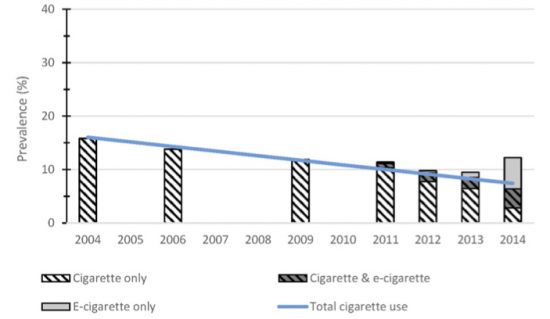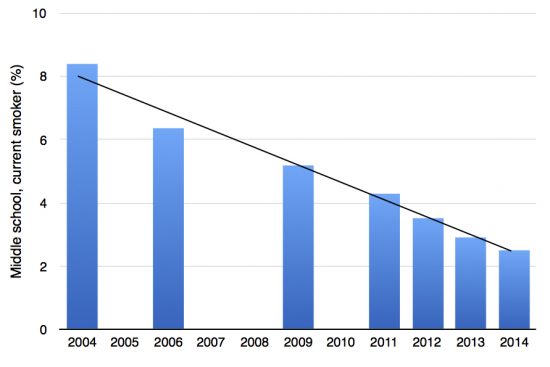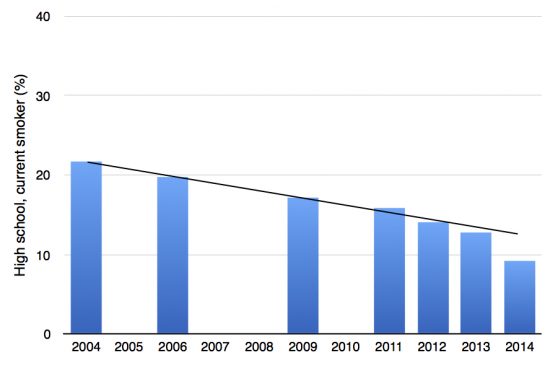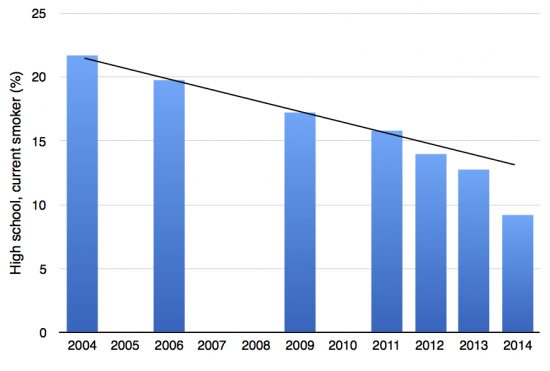Misleading Study Claims Vaping Pushes Youth to Smoking Tobacco
The gateway theory that electronic cigarettes eventually push kids to start smoking has already been debunked numerous times, but it seems vaping opponents are not willing to let scientific evidence and survey data stand in the way of their agenda. A study published in the “Pediatrics” journal this week concludes that vaping is encouraging kids to consume nicotine and creating a new generation of smokers, despite providing no real evidence of this.
 Conducted by Stanton Glantz and Lauren Dutra of the University of California, the “E-Cigarettes and National Adolescent Cigarette Use: 2004 – 2014” looks at data collected in the CDC’s National Youth Tobacco Survey between 2004 and 2014 to see how vaping has influenced smoking among American youths. Previous similar studies have shown that e-cigarettes seem to have accelerated the decrease in tobacco smoking among kids, but Glantz’ controversial research claims the opposite is true.
Conducted by Stanton Glantz and Lauren Dutra of the University of California, the “E-Cigarettes and National Adolescent Cigarette Use: 2004 – 2014” looks at data collected in the CDC’s National Youth Tobacco Survey between 2004 and 2014 to see how vaping has influenced smoking among American youths. Previous similar studies have shown that e-cigarettes seem to have accelerated the decrease in tobacco smoking among kids, but Glantz’ controversial research claims the opposite is true.
“We didn’t find any evidence that e-cigarettes are causing youth smoking to decline, said lead author Lauren Dutra, a former postdoctoral fellow at the UCSF Center for Tobacco Control Research and Education, to which Prof. Stanton Glantz, an ardent opponent of vaping, added “E-cigarettes are encouraging – not discouraging – youth to smoke and to consume nicotine, and are expanding the tobacco market.”
Well, that’s disappointing news, but I’ve learned to take such findings with a grain of salt, especially when Prof. Glantz is involved. In the past, this man has made a variety of wild claims regarding electronic cigarettes, including that the effects of vaping may be just as bad as those of smoking tobacco, and that e-cigarettes actually make it harder to quit smoking. Not only are his statements often unfounded, but they go against the findings of most other researchers. Glantz is a legend of tobacco control, but in recent years he’s embarked on a crusade against electronic cigarette, as if they were even more dangerous than analogs.
In his most recent study, Prof. Stanton Glantz claims to have not only found evidence that the advent of electronic cigarettes did not influence the rate at which tobacco use has declined among U.S. youths, but also that it has had the opposite effect, claiming that the low-risk youth in the study, who went on to smoke regular cigarettes, may not have used nicotine at all if e-cigarettes did not exist. However, that assumption doesn’t sound anything like evidence, and the little pseudo-evidence that the study does show is questionable at best.
Glantz and Dutra graph
That hasn’t stopped big media outlets from posting ominous articles about how electronic cigarettes are corrupting American youths and pushing them to smoking. They always seem more than glad to post controversial research such as this, while completely ignoring objective studies, like the recent report by the University of Victoria, in Canada.
Luckily, there are still a few people willing to call out misleading studies, and even though they can’t make their voices heard in the mainstream media, they make sure that those interested in actual facts learn the truth. Both Dr. Michael Siegel, Professor in the Department of Community Health Sciences at Boston University’s School of Public Health, and Christopher Snowdon, celebrated author whose work focuses on prohibition and dodgy statistics, have contested the finding of this study.
“The researchers showed that experimentation with e-cigarettes did not lead to a decline in smoking. But that’s only half the story,” Dr Siegel write on his blog. “The rest of the story is that experimentation with e-cigarettes did not lead to an increase in smoking.”
“It works both ways. You can’t tell just the half of the story that you happen to like. If this study provides evidence that e-cigarettes didn’t result in a decline in youth smoking because there was no change in the rate of decline then the study also provides evidence that e-cigarettes didn’t result in an increase in youth smoking,” Siegel says.
Christopher Snowdon, on the other hand, has found several technical flaws in the analysis conducted by Glantz and Dutra. One is that even though the authors cite numbers from the CDC’s National Youth Tobacco Survey as the base of their analysis, the graphs posted in their study doesn’t mirror the NYTS data.
NYTS graph
“They claim that ‘Current smoking decreased from 15.8 per cent in 2004 to 6.4% in 2014’ but the only reference Google can find to a smoking rate of 6.4% in 2014 comes from their own study,” Snowdon writes. “The NYTS shows a cigarette smoking rate of 9.2% among high school students and a rate of 2.5% among middle school students.”
NYTS graph
Snowdon also points out that the rate at which smoking has declined among high-school students – who are far more likely to be smokers than middle-school students – has indeed accelerated when e-cigarettes became popular. At least that’s what the NYTS survey data shows, and the trend becomes even more obvious when the vertical axis used by Glantz and Dutra is removed.
NYTS graph
The NYTS graphs clearly show that the youth smoking rates since 2011 – e-cigarettes boomed in 2012 – are lower than they were before 2009, and dropped dramatically in 2014. This certainly doesn’t prove that electronic cigarettes were the cause of the drop in smoking rates – and I’m not going to make the same mistake as the study authors and just assume they were – but they definitely contest the conclusion that smoking rates among youth did not drop at a higher rate since the advent of vaping. As for the claim that e-cigarettes actually encourage smoking, that’s just pure bogus.
Sadly, Glantz continues to spew his hatred for vaping, and with the help of the media he is actually accomplishing what he set out to do – ensure that vaping is perceived as a gateway to smoking, one as dangerous as tobacco. And there’s little anyone can do to stop him.




















